The transient’s key findings are:
- The employment fee for staff ages 51-64 with a incapacity is considerably above the pre-COVID stage.
- Practically the entire employment achieve was in teleworkable jobs, even after accounting for different elements that may have an effect on work exercise.
- The supply of teleworkable jobs inspired some to reenter the labor pressure and others to change to distant jobs as an alternative of exiting the labor pressure.
- Whether or not these results will persist stays unclear, as distant work choices may decline because the labor market returns to extra regular situations.
Introduction
One side of the pandemic that has persevered is the elevated relevance of distant work. This shift may assist older folks with disabilities, who would possibly in any other case discover it exhausting to get or hold jobs. Certainly, this group has the next employment fee post-pandemic than pre-pandemic.
Distant work, although, won’t be the one issue contributing to this development. First, extra folks report having a work-limiting impairment than earlier than the pandemic. If these new well being situations are comparatively gentle, then the rising prevalence of incapacity, by itself, may result in the next employment fee amongst this group. Second, the labor market has been extraordinarily tight in recent times, which may additionally assist enhance employment charges amongst these with disabilities.
This transient, based mostly on a brand new examine, examines the extent to which distant work has contributed to the rising employment fee of older people with disabilities and which varieties of these staff – based mostly on their latest work historical past – have benefited probably the most.1 The dialogue proceeds as follows. The primary part supplies background on the rise of distant work, employment developments for older folks with disabilities, and the 2 different elements that might be enjoying a job: the rising prevalence of incapacity and the tight labor market. The second part introduces the info and methodology for the evaluation. The third part presents the outcomes. The ultimate part concludes that distant work has elevated employment amongst older staff with disabilities by encouraging some to reenter the labor pressure and others to change to distant work as an alternative of exiting the labor pressure.
Background
A putting function of the pandemic was the sudden shift in direction of distant work, and distant work stays a fixture within the labor market (see Determine 1). For staff with disabilities, distant work lowers the fastened price of getting a job by decreasing commuting bills, offering better flexibility, and probably permitting them to entry the nationwide labor market.2 For employers, distant jobs can scale back the prices of hiring as a result of required lodging are already accessible within the employee’s dwelling.3
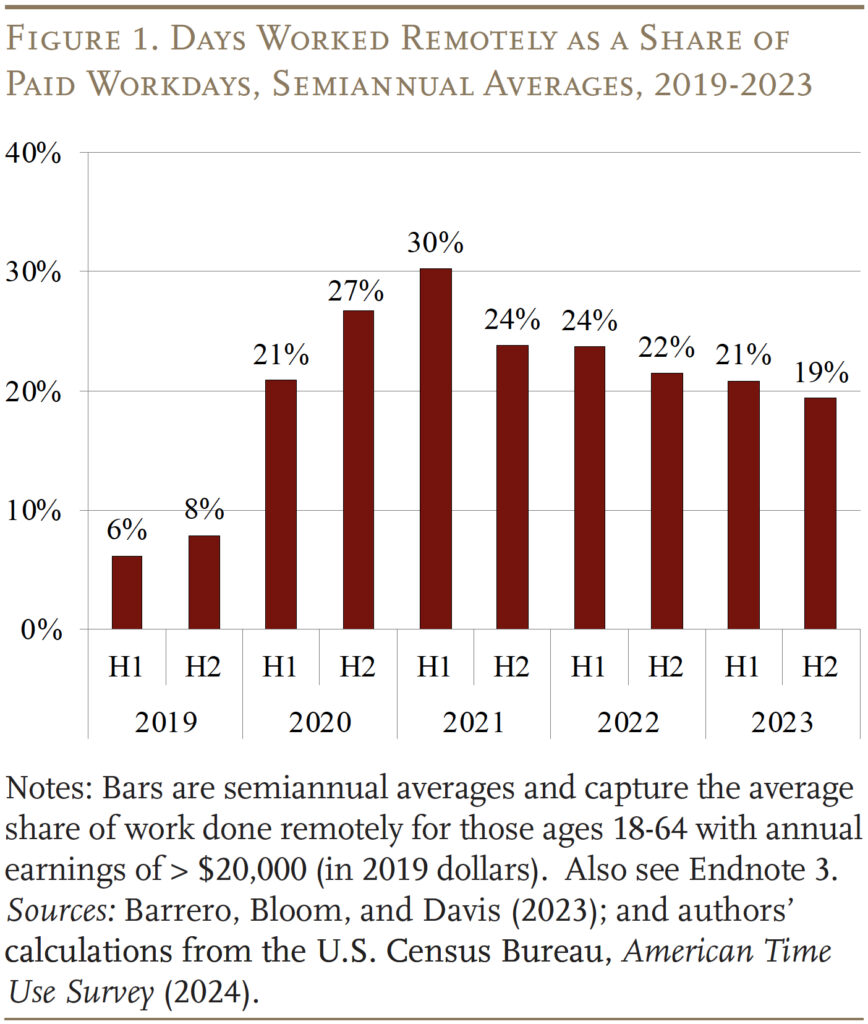
The notion that distant work could also be serving to older staff with disabilities keep within the labor pressure is supported by latest employment developments. Determine 2 reveals that the employment fee for this group rebounded quickly after the pandemic, even rising above pre-pandemic ranges starting in late 2021.4
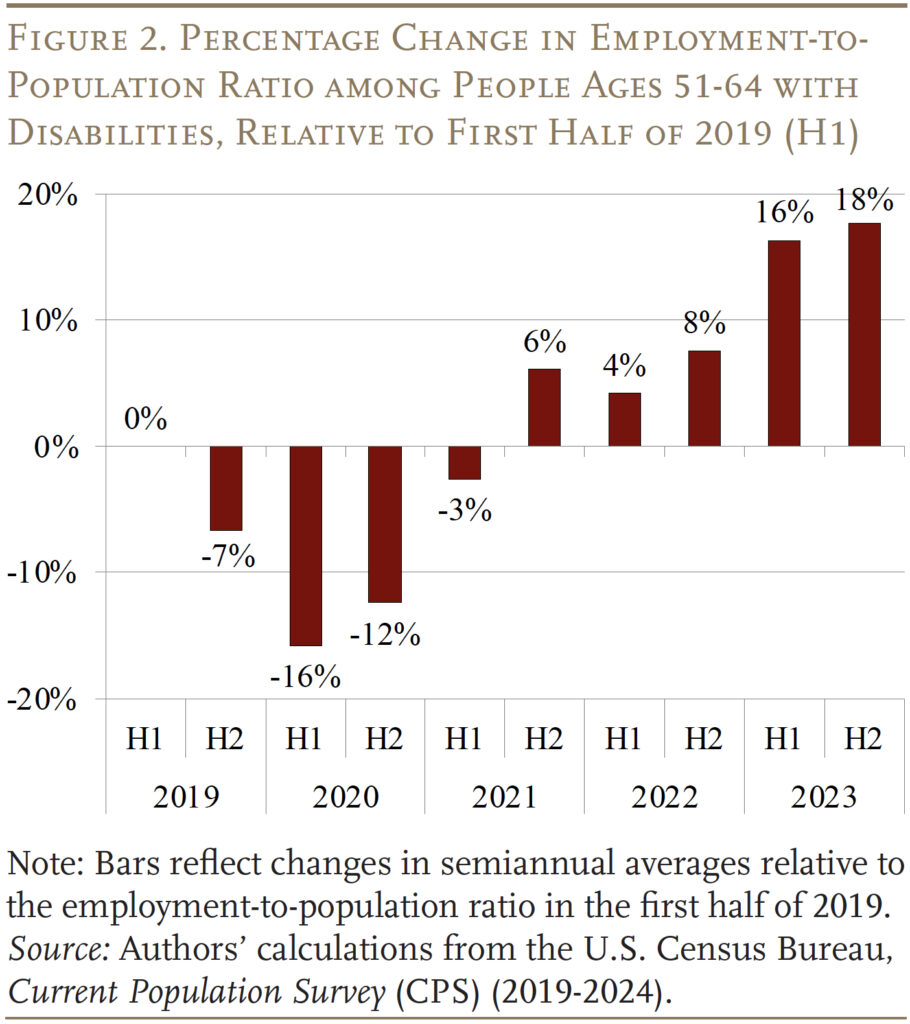
Two different post-pandemic developments, nonetheless, is also influencing employment. First, the next share of the working-age inhabitants now experiences having a incapacity (see Determine 3). A lot of this enhance will be attributed to an increase in self-reported cognitive impairments. Prior research counsel that these new impairments may be circumstances of “mind fog,” a situation associated to lengthy COVID.5 If lengthy COVID is the explanation, it may end in a shift within the composition of individuals with disabilities to these with larger work capability and better attachment to the labor pressure.6 But, as proven in Determine 3, this argument is much less related for older staff, for the reason that rise in incapacity is concentrated amongst youthful staff (ages 18-50).
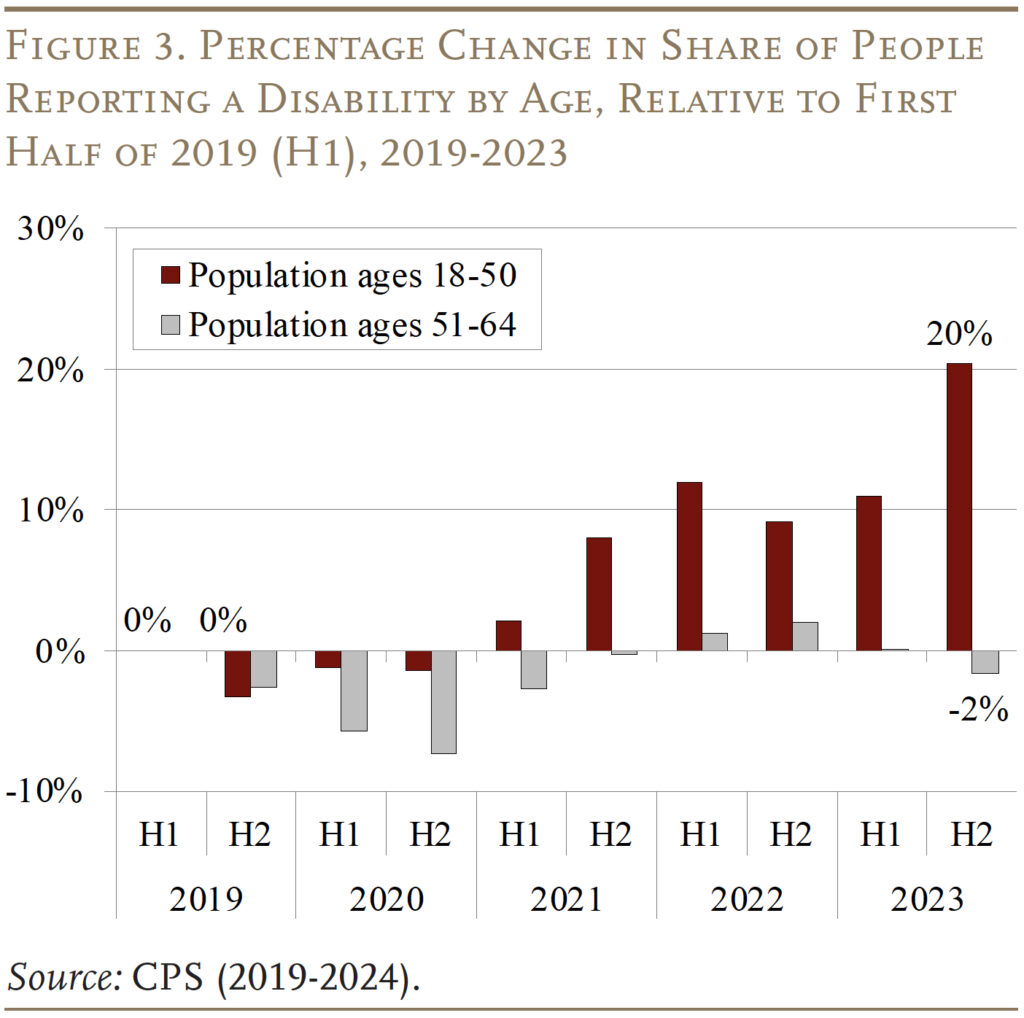
A second, extra convincing, issue is the weird tightness of the labor market in recent times, with the variety of job openings quickly outpacing the variety of unemployed job seekers (see Determine 4). Because of this, extra – and higher-paying – job alternatives have emerged for staff who historically face limitations within the labor market.7 Within the case of staff with disabilities, employers could also be extra keen to supply lodging similar to extra versatile hours and extra frequent breaks.
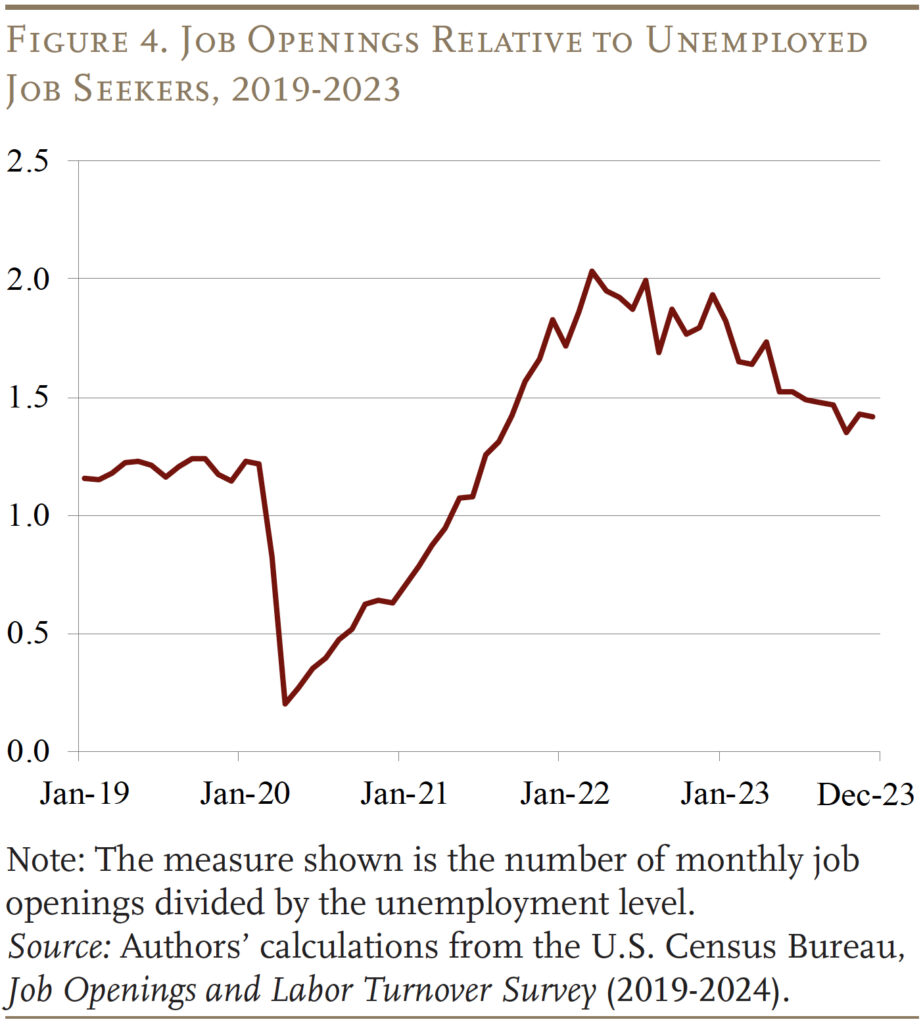
Whereas labor market tightness seems extra prone to have an effect on employment charges amongst older staff with disabilities than the rising share of adults reporting a incapacity, the evaluation will take into account each elements simply in case.
Information and Methodology
The evaluation relies on the 2012-2022 Well being and Retirement Research (HRS), a biennial longitudinal survey of older households with wealthy data on staff’ well being and employment. We give attention to people ages 51-64 who report a work-limiting well being situation and don’t take into account themselves totally retired.8
The evaluation then proceeds in three levels. The primary stage merely paperwork how the rising employment fee for older staff with disabilities breaks down by whether or not their occupation is amenable to distant work.9 If distant work has had an affect, then we’d anticipate the rise within the employment-to-population ratio of individuals in teleworkable jobs to be a lot bigger than the rise for these whose jobs are usually not amenable to distant work.
This easy comparability, nonetheless, doesn’t take into account the potential results of different post-pandemic adjustments. Therefore, the second stage estimates the probability of older folks with disabilities being employed in teleworkable and non-teleworkable occupations, controlling for employee well being and the tight labor market, along with fundamental demographics, utilizing the next equation:10
Employment in teleworkable (nonteleworkable) jobs = f(well being, labor market tightness, demographics, yr 2022)
The yr 2022 variable captures the change in teleworkable (non-teleworkable) employment in 2022 in comparison with 2018 – the omitted reference yr. If distant work has an essential impact on the employment fee – after accounting for employee well being and labor market tightness – then the coefficient on yr 2022 needs to be a lot bigger within the regression for teleworkable jobs than within the non-teleworkable regression.
The ultimate stage of the evaluation explores extra particularly how distant work helps older staff with disabilities keep within the labor pressure based mostly on their latest work historical past, together with their expertise with teleworkable jobs. Particularly, it asks two questions: 1) did distant work persuade these on the sidelines to reenter work, or did it assist those that have been already working to delay exiting the labor pressure? and a couple of) was the affect restricted to those that had prior expertise with distant work, or did all staff profit? To reply these questions, the regression evaluation outlined above is repeated for subgroups of older folks with disabilities based mostly on whether or not they have labored up to now 4 years and whether or not they have had prior expertise in a teleworkable job.11
Outcomes
This part begins by inspecting how distant work improved general employment for older folks with disabilities after which identifies which varieties of these staff noticed the best good points.
How Did Distant Work Have an effect on Older Folks with Disabilities?
To begin off, the evaluation merely breaks down the rise within the employment fee by whether or not the employee’s occupation is teleworkable, with out controlling for incapacity severity or labor market tightness. In step with the CPS knowledge in Determine 2, the rising employment in teleworkable occupations led to an 11.6-percent enhance within the employment-to-population ratio of older folks with disabilities between 2018 and 2022, whereas non-teleworkable employment was just about unchanged (see grey bars in Determine 5).12
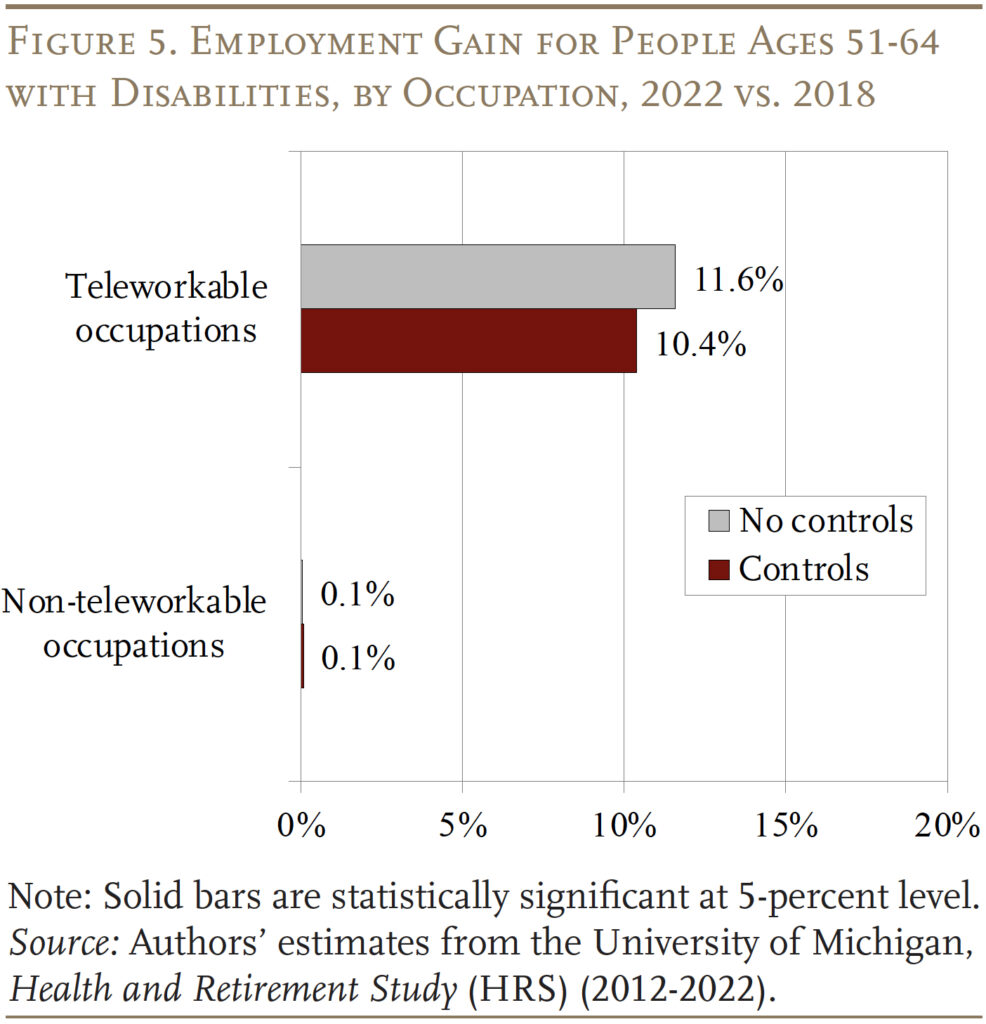
Shifting away from the uncooked comparisons, the regression outcomes present that distant work stays extraordinarily essential even after controlling for incapacity severity and labor market tightness (see high purple bar in Determine 5).13 Certainly, the purpose estimates barely change from the fundamental comparability, suggesting that the 2 probably confounding elements have performed a much less essential position in growing employment for older folks with disabilities.14
Who Benefited the Most from Distant Work?
Provided that distant work has helped enhance employment outcomes for older staff with disabilities, the following query is whether or not a few of them benefited greater than others. Determine 6 compares the proportion change within the employment fee for teleworkable occupations throughout 4 totally different teams of older staff with disabilities. These teams are decided based mostly on two facets of their latest work historical past. The primary side is whether or not or not they have been employed within the final 4 years, whereas the second is whether or not or not that they had prior expertise in teleworkable jobs.

To know the story, take every end in flip. The primary group – those that haven’t labored up to now 4 years and don’t have any expertise in teleworkable jobs – noticed no enchancment: they stayed out of labor. In distinction, the second group – who do have expertise in teleworkable jobs – noticed a big enhance in employment, indicating that they have been higher ready to reenter work as distant jobs surged. The third group is maybe most attention-grabbing. Staff on this group have been employed lately and, regardless of their lack of familiarity with telework, have been capable of transfer into these jobs moderately than exiting the labor pressure due to their incapacity. Lastly, the fourth group – lately working in teleworkable jobs – noticed much less profit from the shift to distant work, maybe as a result of that they had already acquired employer lodging previous to the pandemic, together with the flexibility to telework.
Conclusion
The shift to distant work that began throughout COVID and has persevered might have improved job prospects for older folks with disabilities by decreasing limitations to employment. In step with this view, this transient finds that almost the entire post-pandemic employment achieve for older folks with disabilities has been in teleworkable occupations, and this sample holds even after controlling for different elements. Distant work advantages older staff with disabilities by permitting some to reenter the labor pressure and others to change jobs as an alternative of exiting work.
But, the extent to which these dynamics will persist over the long term stays an open query. This evaluation covers a interval when distant work was significantly widespread. The supply of distant work might decline because the labor market eases again towards extra regular situations. And, the extent to which older staff with disabilities want or wish to work may additionally decline because the affect of bizarre pandemic-era situations – together with the short-term closure of Social Safety discipline workplaces – subsides. Therefore, how distant work impacts older folks with disabilities ought to stay a subject of curiosity.
References
Barrero, Jose Maria, Nicholas Bloom, and Steven J. Davis. 2023. “The Evolution of Work from House.” Journal of Financial Views 37(4): 23-49.
Davis, Owen F., Laura D. Quinby, Matthew S. Rutledge, and Gal Wettstein. 2023. “How Did COVID-19 Have an effect on the Labor Power Participation of Older Staff within the First 12 months of the Pandemic?” Journal of Pension Economics and Finance 22(4): 509-523.
Deitz, Richard. 2022. “Lengthy COVID Seems to Have Led to a Surge of the Disabled within the Office.” Liberty Road Economics. New York, NY: Federal Reserve Financial institution of New York.
Dingel, Jonathan I. and Brent Neiman. 2020. “How Many Jobs Can Be Finished at House?” Journal of Public Economics 189: 104235.
Domash, Alex and Lawrence H. Summers. 2022. “How Tight Are US Labor Markets?” Working Paper No. 29739. Cambridge, MA: Nationwide Bureau of Financial Analysis.
Gascon, Charles S. and Samuel Moore. 2024. “Are Staff with a Incapacity Going through New Alternatives or New Challenges?” On the Economic system Weblog. St. Louis, MO: Federal Reserve Financial institution of St. Louis.
Guo, Angela and Pawel M. Krolikowski. 2024. “Incapacity, Immigration, and Postpandemic Labor Provide.” Financial Commentary 2024-05. Cleveland, OH: Federal Reserve Financial institution of Cleveland.
Liu, Siyan and Laura D. Quinby. 2024. “Has Distant Work Improved Employment Outcomes for Older Folks with Disabilities?” Working Paper 2024-12. Chestnut Hill, MA: Middle for Retirement Analysis at Boston Faculty.
Marks, Cassandra and Hannah Rubinton. 2024. “The Labor Results of Work from House on Staff with a Incapacity.” On the Economic system Weblog. St. Louis, MO: Federal Reserve Financial institution of St. Louis.
Ne’eman, Ari and Nicole Maestas. 2023. “How Has COVID-19 Impacted Incapacity Employment?” Incapacity and Well being Journal 16(2): 101429.
O’Trakoun, John. 2024. “Unsure Outlook for Disabled Employment.” Macro Minute. Richmond, VA: Federal Reserve Financial institution of Richmond.
College of Michigan. Well being and Retirement Research, 2012-2022. Ann Arbor, MI.
U.S. Census Bureau. American Time Use Survey, 2024. Washington, DC.
U.S. Census Bureau. Present Inhabitants Survey, 2019-2024. Washington, DC.
U.S. Census Bureau. Job Openings and Labor Turnover Survey, 2019-2024. Washington, DC.

